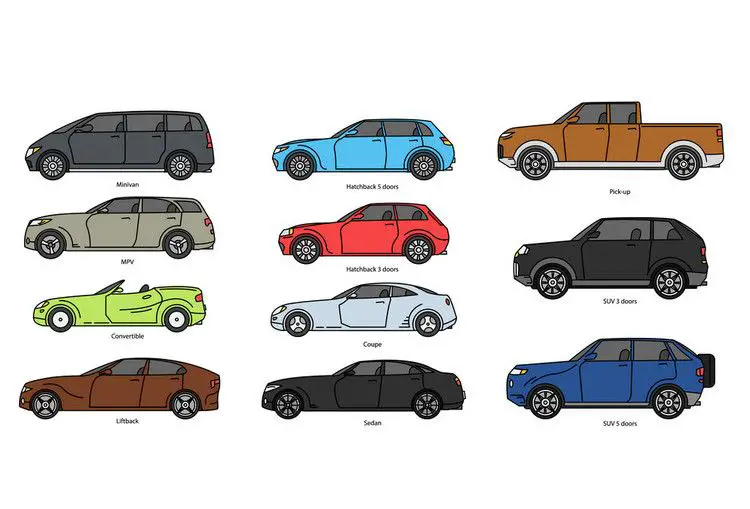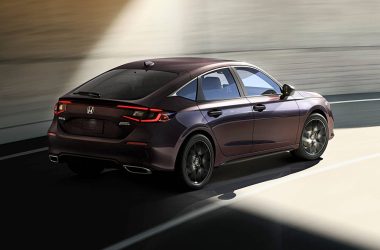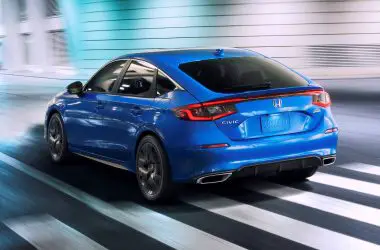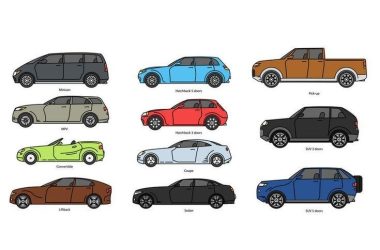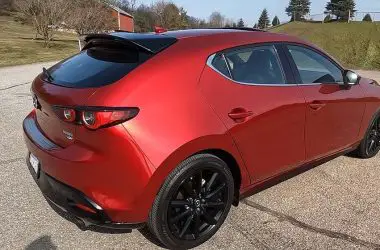Car body styles refer to the overall shape and structure of the vehicle body. Understanding the different types of body styles is important for car buyers, as each style has distinct characteristics that impact performance, cargo capacity, seating layout, and more.
The main car body styles include sedans, coupes, hatchbacks, station wagons, crossovers, SUVs, pickup trucks, and vans. In this article, we will define and explain these major body style categories, discussing the unique benefits and drawbacks of each type.
By learning about the different car body configurations, you can determine which style best aligns with your driving needs and preferences. The body style makes a big difference in how a vehicle drives and what it can be used for, so it is an essential factor to consider when shopping for a new or used car.
Sedan
The sedan is the most common type of car body style. A sedan is defined as a 4-door car with a traditional trunk in the rear. The defining characteristic of a sedan is the separate trunk compartment, as opposed to a hatchback design.
Sedans are known for providing a balance of practicality, comfort, fuel efficiency, and affordability compared to other body styles. Some of the pros of sedans include:
- Spacious interior and seating for 4-5 passengers
- Good cargo space in the trunk
- Smooth ride quality from longer wheelbase
- Better fuel economy than larger vehicles
- Lower cost than coupes or SUVs
Some of the downsides of sedans include less cargo versatility than hatchbacks or SUVs and less sporty handling than coupes. Overall, the sedan remains the quintessential “family car” due to its combination of passenger and cargo space, comfort, efficiency, and value.
Popular sedan models include the Toyota Camry, Honda Accord, and Nissan Altima.
Coupe
A coupe is a car with two doors, a sloping or fastback roofline, and a rear liftgate instead of a trunk. Coupes typically have seating for two or four passengers (Difference Between a Coupe and a Sedan).
The key distinction from a sedan is that coupes have just two doors. However, some four-door vehicles with coupe-like sloping rooflines may also be marketed as “four-door coupes” (Sedan vs. Coupe: How Different Are They?).
Coupes tend to have a sportier, sleeker, and more stylish design than sedans. The sloped roofline and shorter rear overhang give coupes a more dynamic look. The lower roofline also leads to a lower center of gravity, which improves handling. However, the tapering roof reduces rear headroom and cargo space compared to a sedan.
Some popular coupe models include the Ford Mustang, Chevrolet Camaro, BMW 2 Series, and Mercedes C-Class Coupe. Coupes appeal to buyers looking for something more stylish, personal, and nimble than a four-door sedan.
Hatchback
A hatchback is a car body style defined by a rear door that opens upwards to access a cargo area. Hatchbacks combine the passenger-carrying space of a sedan with the utility and flexibility of an SUV or crossover.
Some key differences between hatchbacks and traditional sedans include:
- Hatchbacks tend to have a shorter, stubbier profile than sedans. The sloped rear roofline of a sedan is replaced by a more vertical hatchback rear profile.
- Hatchbacks prioritize cargo space and accessibility over the sleek styling of a sedan. The large rear hatch door provides easy access to the cargo area.
- Hatchbacks offer more versatile interior space and cargo room. The fold-down rear seats allow larger items to fit.
Compared to an SUV, hatchbacks offer better fuel economy and a lower center of gravity for sportier handling. However, SUVs tend to have more ground clearance and interior space.
Some example hatchback models include the Volkswagen Golf, Honda Civic, Hyundai Elantra GT, and Kia Forte5.
Station Wagon
A station wagon is a vehicle with a full passenger cabin and an elongated roof over a rear cargo area. They typically have 4- or 5-doors and an upward swinging liftgate at the rear for access to the cargo bed. Station wagons blend the utility of a hatchback with the looks and interior comfort of a sedan.
The history of station wagons dates back to about 1910, when various luxury carmakers began extending the roofline of cars to create enclosed cargo beds. They became especially popular in the US in the 1950s as family cars with ample room for kids, gear and pets [1]. The 1970s energy crisis led to a decline of station wagons, but modern iterations with sleek looks and performance orientations have revived their popularity.
Some pros of station wagons include their practicality, space, and flexibility to handle both passengers and cargo. They also often have a smoother ride than large SUVs. Downsides can include poorer fuel efficiency compared to sedans, less cockpit space, and a staid reputation.
Today, station wagons come in many shapes and sizes. Some modern examples include the Subaru Outback, Audi A6 Allroad, Volkswagen Golf Sportwagen and Mercedes-Benz E-Class Wagon. Upscale brands like Porsche and BMW also offer high-performance wagons for driving enthusiasts.
Crossover
A crossover, sometimes called a CUV (Compact Utility Vehicle), is a vehicle that combines elements of an SUV with features more commonly associated with passenger cars. Crossovers are built with unibody construction, like passenger cars, which makes them lighter and more fuel-efficient than traditional SUVs that use body-on-frame construction.
The key differences between a crossover and a traditional SUV are:
- Crossovers ride lower to the ground than SUVs, making it easier for passengers to get in and out. Their suspension is tuned more for a comfortable on-road ride than off-road capability.
- Crossovers are typically smaller than SUVs, and their interiors are designed with 4-5 passengers in mind rather than 7-8 like a full-size SUV.
- Crossovers are primarily front-wheel drive, though all-wheel drive is optional. SUVs are usually rear-wheel drive or four-wheel drive.
- Crossovers prioritize fuel economy, while SUVs emphasize utility and hauling capability.
Some of the advantages of crossovers compared to SUVs are better fuel economy, easier handling, and a more car-like interior and ride quality. Downsides are less passenger and cargo room versus a comparably sized SUV. Overall, crossovers offer a versatile blend of comfort, efficiency, and utility in a more compact, maneuverable package.
Some of the best-selling crossover models are the Honda CR-V, Toyota RAV4, Nissan Rogue, Ford Escape, Chevrolet Equinox, and Subaru Forester.
SUV
An SUV (sport utility vehicle) is a car classification that combines elements of road-going passenger cars with features from off-road vehicles like raised ground clearance and four-wheel drive.
There are many types of SUVs:
- Compact SUVs like the Honda CR-V and Toyota RAV4 are smaller and more fuel efficient.
- Midsize SUVs like the Toyota Highlander and Ford Explorer offer more cargo and passenger room.
- Full-size SUVs like the Chevy Tahoe and Ford Expedition are truck-based SUVs with three full rows of seating.
- Luxury SUVs like the Lexus RX and BMW X5 offer premium features and styling.
- Off-road SUVs like the Jeep Wrangler and Toyota 4Runner are designed for serious off-roading capabilities.
Some key pros of SUVs are cargo capacity, passenger room, available all-wheel drive, and increased ride height. Some cons are higher fuel consumption, more difficult handling, and higher cost compared to smaller vehicles. SUVs are popular with families and outdoor enthusiasts.
According to Kelley Blue Book, some of the most popular SUVs in 2023 so far are the Tesla Model Y, Toyota RAV4, Honda CR-V, and Nissan Rogue.
Pickup Truck
Pickup trucks, also known as light trucks, are versatile vehicles characterized by an enclosed cab and an open cargo bed in the back. What defines a pickup truck is the open cargo area which allows for hauling various types of cargo and equipment.
There are several types of truck beds including the standard bed, short bed, and long bed. Short beds range from 5 to 6 feet in length while standard beds are around 6 to 8 feet. Long beds can extend up to 9 feet in length and are preferred for maximizing cargo capacity.
Some pros of pickup trucks are their durability, customizability, passenger capacity, and towing abilities. They excel at hauling heavy loads and equipment especially for work or recreation. The open bed provides flexible cargo space. However, pickup trucks typically get lower gas mileage compared to sedans and have a higher purchase price.
Pickup trucks are ideal as work vehicles for construction, farming, and commercial use. They can haul tools, materials, and equipment to job sites with ease. Many homeowners also use pickup trucks for yardwork and DIY home projects. Pickups work well for recreational activities like camping or boating where extra cargo room is needed.
According to Statista, the Ford F-150 has been the best-selling pickup truck in the US market in 2023 selling over 750,000 units so far.
Van
Vans are vehicles that are built on a truck chassis but have an enclosed, box-like cargo area. Compared to a pickup truck, vans have higher rooflines and taller cargo areas. There are two main types of vans: cargo vans and passenger vans.
Cargo vans are designed to maximize cargo capacity for commercial use. They have minimal rear seating and mostly empty rear compartments. Some popular cargo van models include the Volkswagen Transporter, Ford Transit, and RAM ProMaster. Cargo vans provide lots of space to transport tools, equipment, and other goods for tradespeople and businesses. Their boxy shape also makes them easy to load and unload. Downsides are poorer fuel economy and handling compared to passenger vehicles.
Passenger vans have more comfortable interior seating for transporting groups of people. Some models like the Chrysler Pacifica have captain’s chairs while others like the Ford Transit have bench seating for 7 to 15 passengers. Passenger vans are popular with families, airport shuttles, churches, schools, and tour groups. Their large interiors provide plenty of room for people and luggage. Drawbacks include worse maneuverability, parking, and braking than a typical passenger car.
Conclusion
Cars come in a diverse array of body styles to suit different needs. Sedans provide a balance of practicality, style and fuel efficiency. Coupes are sporty and stylish with two doors and limited rear-seat space. Hatchbacks have a large rear opening for cargo capacity. Station wagons maximize cargo and passenger room. Crossovers blend car and SUV traits for a versatile on- and off-road option. SUVs offer capability to haul people and gear in challenging conditions. Pickups provide unmatched utility for towing and hauling over all terrain. Vans bring expansive cargo room for commercial tasks or large families.
When selecting a new car, it’s important to choose the body style that aligns with your priorities. Understanding the strengths of each allows you to pick the optimal blend of form and function. While exterior styling is key, also consider interior space, seating layout, cargo capacity, off-road ability and efficiency. Test drive styles that seem appealing to experience the benefits first-hand.
